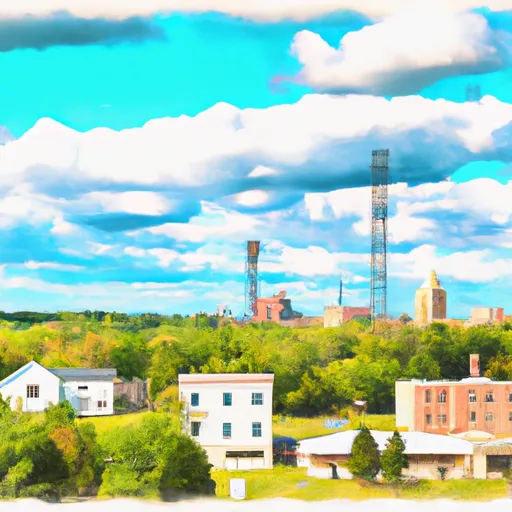-
 Snoflo Premium
Snoflo Premium
Get unlimited access to all our content
With no Ad interruptions! - Start Your Free Trial Login with existing account
Raco
Eden Index
Climate
5.6
•
Recreation
6.5
•
Community
•
Safeguard
4.5/10

Raco is a small unincorporated community located in Chippewa County, Michigan. Situated in the Upper Peninsula, Raco experiences a humid continental climate, characterized by cold winters and mild summers. Winter temperatures can drop below freezing, with snowfall being common due to its proximity to Lake Superior. Summers are relatively mild, with temperatures averaging in the low to mid-70s°F.
Raco is surrounded by several hydrology constituents, including the Raco River, which flows through the area, and numerous lakes and ponds. These water bodies provide excellent opportunities for fishing, boating, and other water-based activities. Fish species commonly found in the area include walleye, northern pike, muskie, and various trout species.
Outdoor enthusiasts will find plenty of recreational opportunities in Raco. The proximity to Hiawatha National Forest offers hiking, camping, and wildlife viewing opportunities. The area is also popular for hunting during the appropriate seasons, with an abundance of deer, small game, and waterfowl. Additionally, Raco is close to various off-road trails, making it a great destination for ATV and snowmobile enthusiasts.
What is the Eden Index?
The Snoflo Eden Index serves as a comprehensive rating system for regions, evaluating their desirability through a holistic assessment of climate health, outdoor recreation opportunities, and natural disaster risk, acknowledging the profound impact of these factors on livability and well-being.
Climate Health Indicator (CHI): 5.6
Raco receives approximately
828mm of rain per year,
with humidity levels near 83%
and air temperatures averaging around
5°C.
Raco has a plant hardyness factor of
4, meaning
plants and agriculture in this region thrive during a short period during spring and early summer. Most
plants will die off during the colder winter months.
By considering the ideal temperature range, reliable water supplies, clean air, and stable seasonal rain or snowpacks, the Climate Health Indicator (CHI) underscores the significance of a healthy climate as the foundation for quality living.
A healthy climate is paramount for ensuring a high quality of life and livability in a region, fostering both physical well-being and environmental harmony. This can be characterized by ideal temperatures, reliable access to water supplies, clean air, and consistent seasonal rain or snowpacks.
Weather Forecast
Streamflow Conditions
Southeastern Lake Superior
Area Rivers
Southeastern Lake Superior
Snowpack Depths
Southeastern Lake Superior
Reservoir Storage Capacity
Southeastern Lake Superior
Groundwater Levels
Recreational Opportunity Index (ROI): 6.5
The Recreational Opportunity Index (ROI) recognizes the value of outdoor recreational options, such as parks, hiking trails, camping sites, and fishing spots, while acknowledging that climate plays a pivotal role in ensuring the comfort and consistency of these experiences.
Access to outdoor recreational opportunities, encompassing activities such as parks, hiking, camping, and fishing, is crucial for overall well-being, and the climate plays a pivotal role in enabling and enhancing these experiences, ensuring that individuals can engage in nature-based activities comfortably and consistently.
Camping Areas
| Campground | Campsites | Reservations | Toilets | Showers | Elevation |
|---|---|---|---|---|---|
| Brimley State Park | 235 | 628 ft | |||
| Beach - Pancake Bay Provincial Park | 236 | 614 ft | |||
| Soldier Lake Rec Area | 43 | 908 ft | |||
| Crescent Lake - Lake Superior Provincial Park | 20 | 1,184 ft | |||
| Agawa Bay - Lake Superior Provincial Park | 147 | 620 ft | |||
| Hilltop - Pancake Bay Provincial Park | 89 | 657 ft | |||
| Monocle Lake Rec Area | 39 | 641 ft | |||
| Kinross RV Park East | 64 | 781 ft | |||
| Rabbit Blanket Lake - Lake Superior Provincial Park | 60 | 1,126 ft | |||
| Bay View | 24 | 622 ft |
Nearby Ski Areas
Catastrophe Safeguard Index (CSI):
The Catastrophe Safeguard Index (CSI) recognizes that natural disaster risk, encompassing floods, fires, hurricanes, and tornadoes, can drastically affect safety and the overall appeal of an area.
The level of natural disaster risk in a region significantly affects safety and the overall livability, with climate change amplifying these risks by potentially increasing the frequency and intensity of events like floods, fires, hurricanes, and tornadoes, thereby posing substantial challenges to community resilience and well-being.
Community Resilience Indicator (CRI):
The Community Resilience Indicator (CRI) recognizes that education, healthcare, and socioeconomics are crucial to the well-being of a region. The CRI acknowledges the profound impact of these elements on residents' overall quality of life. By evaluating educational resources, healthcare accessibility, and economic inclusivity, the index captures the essential aspects that contribute to a thriving community, fostering resident satisfaction, equity, and social cohesion.

